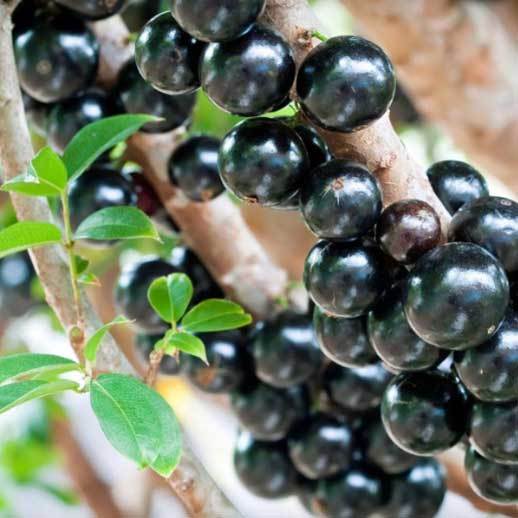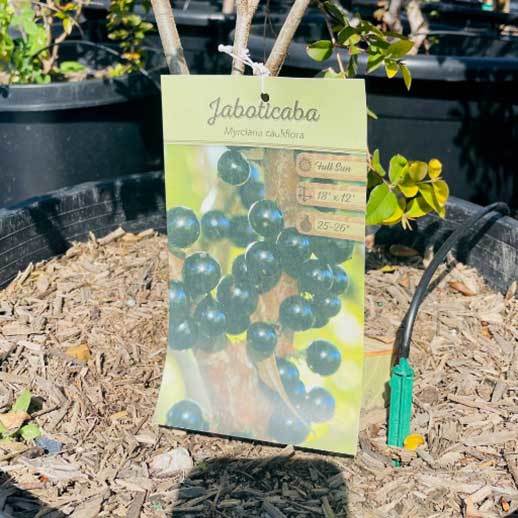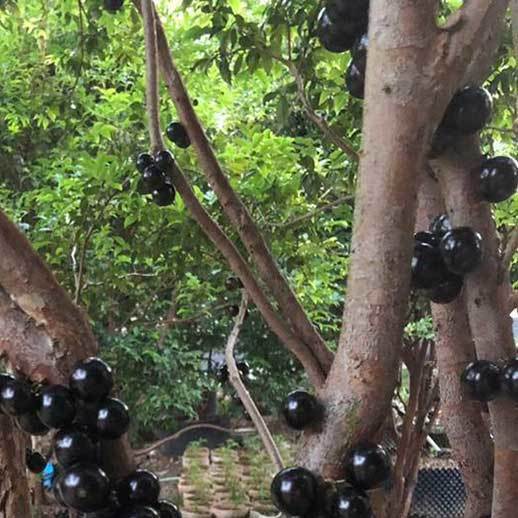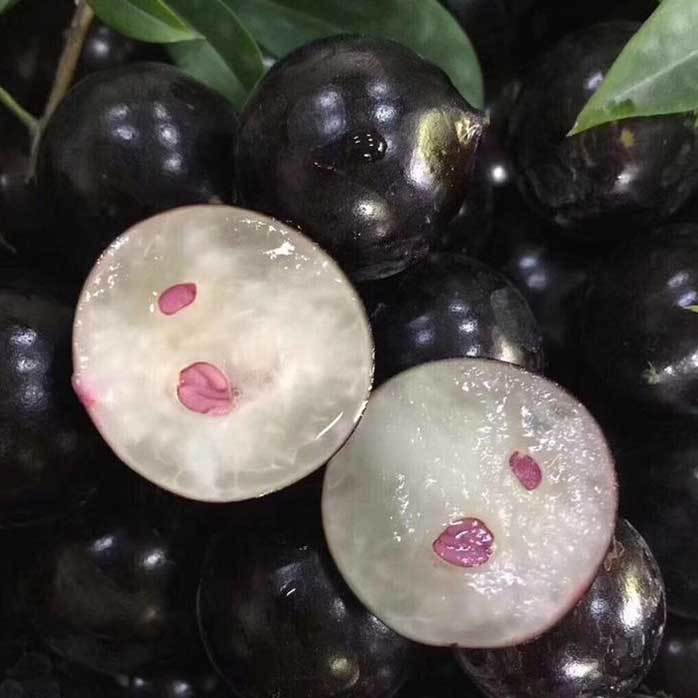The Ultimate Guide to Growing Jaboticaba in Pots: A Step-by-Step Approach for Success
Introduction
Brief overview of Jaboticaba: Jaboticaba, scientifically known as Myrciaria cauliflora, is an attractive fruit bearing evergreen shrub native to Brazil but now cultivated in many areas around the world. It produces edible berries that are juicy with sweet-tart flavor and can be eaten fresh or used to make drinks and other food products. The plant has lush foliage with reddish bark, making it visually appealing whether fruiting or not.
Benefits of growing jaboticaba in pots: The main advantage of growing jaboticaba trees in pots is the ease of cultivation. By planting in a container, you don’t need to have a large garden or backyard, since jaboticaba trees do well in containers as small as 10-16 inches.
Planting Jaboticaba Tree in a pot also helps reduce pests and diseases. It allows better control of water distribution while preventing root rot due to over-watering. Planting jaboticaba in pots offers better control over the environment, enabling you to adjust the pot size according to the jaboticaba growth rate and pruning needs.
It also makes fertilisation easier because you have direct control over their nutrients level. You'll know exactly how much fertilizer and micronutrients are needed by your plant. This gives you greater flexibility when it comes to providing specific levels of nutrition for maximum productivity.
Introduction to the guide and its purpose: In this guide we will cover all aspects related to growing Jaboticaba in pots, from soil preparation and planting to pruning and care. We’ll also share many tips for getting the most out of your jaboticaba potted plants. After reading this guide, you will have a good understanding of the benefits of growing Jaboticaba in pots, as well as an idea of how to properly do it.

Understanding Jaboticaba
Description of Jaboticaba Plant and Fruit: Jaboticaba is an evergreen tree native to South America. The jaboticaba tree height can reach up to 25 feet tall with grayish-brown bark. The drooping branches bear glossy green leaves and clusters of grape-like fruits. The unique fruit has a thin skin that easily peels away to reveal a white or pink flesh.
Different Jaboticaba Varieties: You can grow Jaboticaba tree in USDA Plant Hardiness Zone 9-11 with no winter protection. There are several varieties of jaboticaba available depending on your growing zone. For example, you can grow the common black-fruited variety (Myrciaria cauliflora). All varieties have similar growth habits and require similar care. In addition, hybrid varieties are gaining popularity due to their superior flavor and higher yields.
Nutritional and Health Benefits of Jaboticaba: The jaboticaba fruit is packed with nutrition-rich vitamins and minerals. This can help protect against various illnesses. The high level of antioxidants present in jaboticaba can even reduce the risk of cancer and heart disease.
Selecting the Right Pot and Soil
Choosing the appropriate pot size: The size of your pot is important. Too small and the tree's root system won't have enough room to expand, while a pot that's too large can cause waterlogging, leading to root rot. As a general rule of thumb, select a pot that is two or three times as wide as its existing root ball for best results.
Ideal Pot Materials for Growing Jaboticaba: Opt for pots made of material like terracotta or plastic that allow good drainage so excess moisture can escape. Clay pots are popular because they’re lightweight and allow for better airflow. But make sure to choose one with a drainage hole at the bottom.
Importance of Drainage and Proper Watering Techniques: A jaboticaba tree needs consistent watering to survive. However, you should avoid over-watering because this will lead to root rot. Choose a pot with drainage holes so that excess water can escape quickly. You also can consider adding additional holes if needed. Additionally, opt for a self-watering planter, so you don't have to worry about frequent manual watering sessions.
Creating a Suitable Potting Mix for Jaboticaba: To ensure your jaboticaba has enough nutrients to thrive, create a rich potting mix with compost and organic matter. You should also add expanded perlite or coarse vermiculite to promote drainage and retain moisture.
Additionally, consider adding a slow-release fertilizer for extra nourishment and sustained growth. With the right potting mix in place, your jaboticaba will be well on its way to thriving!
Growing Jaboticaba From Seed
Harvesting and preparing jaboticaba seeds: Harvesting and preparing jaboticaba seeds for propagation is relatively simple, but it’s important to do so at the right time of year. Look for newly ripe, dark purple fruits in late summer or early fall.
Cut them open to reveal the white seeds encased in jelly-like matter inside each fruit. You should scoop out the seeds with a spoon. Rinse them with cool water. Lay the seeds on paper. Then, you can store them when they are completely dry.
Germination process and tips for success: Fill a shallow plastic seed tray with well-draining soil mix and place the seeds onto the surface. Cover them with a thin layer of soil and make it moist. Then, cover the tray with plastic wrap to keep in moisture.
You should place it in warm temperatures between 21-29°C and the place should have indirect sunlight. The seeds will germinate within two to three weeks. Then, you can transplant them into individual small pots or containers.
Growing Jaboticaba From Cuttings
For those looking for a faster route, consider grafting techniques. Grafting is a method of joining a scion (the stem or bud) and rootstock together so that the two plants form one single plant. This can be done by using cleft grafts, bark grafts, T-budding or side veneers.
Choosing the right rootstock and scion: In order for your graft to be successful, it's important to match compatible plants together. This means matching species with similar characteristics such as flowering time and growth habits. Make sure both parts are healthy and free from diseases or pests by inspecting their leaves closely.
Step-by-step grafting process: You can use a knife to make a diagonal cut about two-thirds of the way through the rootstock stem. Make another cut on the scion, this time creating an inverted “V” shape. Line up these cuts and fit them together so that they are snugly joined. Secure them with plant tape or grafting clips until healed (about 2-3 weeks).
Afterward, you can remove the tape and keep the plant in a warm area with indirect sunlight where it will receive plenty of water as it continues to grow. If done correctly, your grafted jaboticaba should begin growing within a few weeks.

Optimal Jaboticaba Growing Conditions
Sunlight requirements for jaboticaba: Jaboticabas are full sun plants that require at least 6 hours of direct sunlight each day. In its native Brazil, jaboticabas prefer higher temperatures and humidity levels than most other climates can provide.
Temperature and humidity considerations: You should keep jaboticaba in an area of your home that has little fluctuation. They are sensitive to changes in temperature and other environmental conditions. Aim for temperatures between 15-26°C with higher humidity levels. You can achieve this by misting the plant regularly, or using a humidifier in the same room as the tree.
Wind protection and suitable microclimates: Wind protection is also essential for this tropical fruit tree, as the branches and fruit are delicate. You should provide some windbreaks or barriers if you live in a climate with particularly strong winds.
Indoor vs. outdoor cultivation: You can grow jaboticaba indoor or outdoor. Growing plants indoors is great if you don't have access to a yard or have limited space. However, an outdoor location allows your tree’s roots to spread out, which can lead to a larger and more fruitful harvest.
When growing this tropical fruit tree indoors or in a pot, take care to replicate these conditions as closely as possible for the best results. You'll need to think about air circulation; make sure the location has good airflow to prevent your tree from being damaged by wind or pests.
With some patience, your jaboticaba tree will produce delicious, juicy fruit for years to come. The process may seem intimidating, but with a bit of patience and dedication, you can have your own successful jaboticaba tree growing in no time.
Planting and Transplanting
Preparing the pot for planting: An indoor pot will provide more optimal jaboticaba tree growing conditions and environmental control. You should start with a container that is large enough to accommodate your jaboticaba plant without crowding it. The minimum size for a single tree should be 12 inches in diameter and 14-16 inches deep.
Transferring the jaboticaba plant to the pot: You can fill it with well-draining soil which is enriched with organic matter. You also need to utilize a few inches of gravel at the bottom of your pot for adequate drainage.
Proper planting depth and spacing: When transferring your jaboticaba plant to the plastic plant pots, you should ensure that the root ball is completely covered with soil. Sits it about 1 inch below the rim for best results. Additionally, you should space multiple plants at least 6-12 inches apart to prevent overcrowding.
Watering and Fertilizing
Establishing a watering routine: The amount and frequency should depend on the climate and soil conditions. In general, aim to water the potting mix whenever it has dried out at least 1-2inches deep. This will allow the soil to retain enough moisture for the jaboticaba’s roots. You should water more often than someone living in a wetter area if you live in a dry climate.
Recognizing signs of under or over watering: It is important for optimal jaboticaba growth. Signs of overwatering include yellow leaves, wilting, and root rot. Signs of underwatering include dry leaves and soil, leaf drop, and poor fruit production.
Selecting appropriate fertilizers and their application: They are essential to healthy plant growth. Slow-release fertilizers are preferred since they offer a steady supply of nutrients to the jaboticaba without burning its roots. You may need to supplement with additional micronutrients like iron and magnesium for healthy fruit production. It depends on your soil testing results.

Pruning and Training
Understanding the growth habit of jaboticaba: Jaboticaba grows branches that are highly flexible, making it easy to shape them as desired. Pruning should be done in winter when the jaboticaba bonsai tree is dormant. Pruning should be done during this time to shape and maintain its form, as well as encourage fruit production. When pruning jaboticaba, it is important to remember that most of the fruiting happens on new wood. As such, young branches need to be protected from heavy pruning so they can bear fruit.
Pruning techniques for shaping and maintenance: You can use pruning technique to encourage fruit production and maintain the desired tree shape such as thinning or shaping. You should use certain pruning techniques at certain times to keep the plant healthy.
Training methods to encourage fruit production: Training jaboticaba is also important to ensure it produces enough fruit. Training the plant into an espalier or fan shape. This can help maximize yields by making sure all parts of the tree get adequate sunlight and airflow, resulting in more flowers and fruits. It is also important to add stakes or trellises when training your jaboticaba to prevent branches from breaking.
Timing and frequency of pruning: You can prune and train at least once or twice a year. Frequent pruning is necessary for keeping your jaboticaba in shape and maximizing fruit production. With the right techniques and timing, you can have a healthy jaboticaba tree with plenty of fruits all year round.
Additionally, training methods such as trellising or espaliering can be used to encourage fruit production and promote healthy growth. Pruning and training jaboticaba should be done regularly in order to maintain its shape and health, so make sure you are keeping track of your timing and frequency of pruning as well.
Pest and Disease Management
Common pests affecting jaboticaba: Jaboticaba plants are susceptible to certain pests such as mealybugs, spider mites, scale insects and ants.
Organic pest control methods: It includes releasing ladybugs or lacewings into your garden to help keep pests under control. You can use horticultural oils or neem oil mixed with water in a spray bottle to target specific problem areas. Additionally, applying mulch around the base of the plants can help reduce weed growth and provide some protection from pests.
Identifying and treating common diseases: You should regularly inspect the plant for signs of disease. Common diseases affecting these plants include leaf spots, stem cankers, root rot and rust.
Symptoms of disease include stunted or yellow leaves, leaf spots, wilting stems or areas of discolored bark. You should remove any surrounding material to reduce the spread of the disease. You can consider replacing diseased plants with resistant varieties or cultivars once removed.
Finally, to prevent diseases from taking hold in your garden, you should avoid overhead watering, only planting disease-resistant cultivars, proper pruning and training, and providing adequate air circulation.
Harvesting and Enjoying Jaboticaba Fruits
Jaboticaba how long to fruit? Jaboticaba Tree will take around 8 years to fruit. It depends on tree age and environmental conditions.
Determining the right time for harvest: Its colour will tell if the fruit is ready to pick. Jaboticaba fruits are ripe and ready for harvest when the skin turns from green to deep purple or black. You should also look out for any browning on the fruit's surface because the jaboticaba is overripe and not suitable for harvesting. Additionally, you can try gently pressing the fruit; if it easily gives under your finger, then it's ready to be picked.
Harvesting techniques for preserving fruit quality: You can use several harvesting techniques to preserve the quality of the fruit when the jaboticaba is ripe. Don't damage the branches or trees when harvesting. This can affect the health of the tree and reduce future crop yields. Use sharp pruning shears to cut the fruit directly off the branch. You should handle the fruit gently because bruising or rubbing can decrease its shelf life.
Storing and using jaboticaba fruits: You should store jaboticaba fruits in the refrigerator as soon as possible after harvest. This will help to preserve their freshness and flavor for up to six months.
You can just enjoy it fresh by tossing it into a salad or having it as a snack. You can also make jam or jelly with the fruit for spreadable treats. For a unique twist on desserts, try making jaboticaba tarts with a buttery crust and sweet custard filling. Or, whip up some jaboticaba muffins to enjoy for breakfast.

Troubleshooting Common Issues
Yellowing leaves and nutrient deficiencies: Yellowing leaves in jaboticaba plants can be a sign of nutrient deficiency, such as nitrogen or potassium. You can add organic fertilizers like compost or fish meal into the soil to address this. Additionally, supplement fertilizer with micro-nutrients, like zinc sulfate, to correct any deficiencies.
Leaf drop and water-related problems: Jaboticaba plants are quite sensitive to overwatering or underwatering. You should ensure an even balance of moisture in the soil but not overly wet or dry conditions. Too much water can cause root rot and leaf drop while too little can cause wilting and yellowing leaves. Monitor the soil moisture by using a moisture meter to ensure adequate water levels.
Addressing fungal infections and diseases: Fungal infections can be prevented by regularly inspecting your jaboticaba plants for any signs of disease, such as discolored or wilted leaves. Treat fungal infections with a fungicide and use preventive measures such as watering practices, good air circulation and avoiding over-fertilizing.
Troubleshooting growth and fruiting challenges: You should consider adjusting the amount of sunlight the plant receives if your jaboticaba plant is not growing or producing fruit. Aim for six to eight hours a day of direct sunlight and adjust light levels as the fruit ripens. Additionally, prune branches regularly and thin out excessive fruits near the end of summer to promote healthy growth and fruiting.
Conclusion
In conclusion, growing jaboticaba in pots can be a rewarding experience. This guide has covered the key tips and tricks for successfully doing so: from choosing and preparing a pot to planting the right variety of jaboticaba and caring for it throughout its life cycle.
We hope this guide has inspired you to give growing jaboticaba in pots a try. You can start small and then continue to expand as your knowledge base grows. You’ll be able to enjoy the delicious fruits of your labour soon!
To ensure success when growing jaboticaba in pots, remember these final tips: choose the right pot and soil for the job; water appropriately; and provide good light and air circulation. With these basic guidelines, you’ll be a jaboticaba-growing expert in no time.




